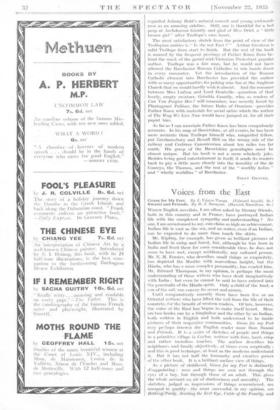Voices. from the East
Wiucii English novelists, I am often asked by literary friends, both in this country and in .France, have portrayed. Indian life with the completest sympathy and understanding ? No one, I am accustomed to say, can claim so high an achievement. Indian life is vast as the sea, and no writer, even if an Indian, can be expected- to do more than touch the skirts.
Mr. Kipling, for example, has given us brilliantyietureS of Indian life in camp and forest, but, although' he Was born in India and lived there for some -considerable time, he does not seem to have met, except accidentally, any cultured person. Mr. E. 111, ,Forster, who describes small things so exquisitely, has depicted the Muslim with marvellous insight, but the Hindu, who has a more complex personality, has evaded him. Mr. Edward Thompson, in my opinion, is perhaps the most understanding of those writers who have dealt imaginatively with India ; but even he cannot be said to have entered into the penetralia of the Hindu spirit. Only a child of the land, a son of the soil, can convey its secret and aroma.
Until comparatively recently there have been few or no Oriental authors who have lifted the .veil from the life of their countries for the benefit of western readers. Of late, however, the voice of the East'-has-begun to make itself heard. Here are two books,.one by a Singhalese and the other by'-an both wiltten in English and both understood -to be inside pictures of their respective communities. Grass for my Feet may perhaps interest the English reader more than Swami and Friends. .It is a series of sketches of people and things in a primitive village in Ceylon, written with lirM, hard, crisp and rather merciless touches. The author describes his neighbours and family objectively, at' times even sceptically ; and this is good technique, utleast -as.the moderns understand it. But it has not half the humanity and creative power of the other book. It is a brilliant surface view of things. As a picture of childhood, Grass for my ,F:,eet is distinctly disappointing : men and things arc seen mat through the eyes of a boy, but through those of an -adult. This gives the whole account an air' of shadowiness and unreality. -The sketches, judged as impressions of things remembered, arc unequal in quality-7-the most successful, in my opinion, are .1311thlitVM4wAverting -the evil Eye; Cattle' of -Ike -Pa and Spreading Wings. All these have have a sharpness or terseness of outline that is quite effective. With Swami and Friends, we are in a different atmosphere —an atmosphere at once less sophisticated and more poetically true. The cultured. Englishman will find it a revelation. .He would feel as though a new world had opened before him. The book deals with the boyhood experiences of a lad named Swami, and it gives us wonderful pictures of his friendships, his little exploits, his hopes and fe4rS, This is ehildhOod pure and simple. The portrait of the grandmother, who is per- petually somnolent and for whom modern life has no sign- ficance, is one of the best things in a full and vivid gallery,- There is not a single dull page in the• whole work, and the simple effortless method of the telling 'harmonises perfectly with the theme of childhood. This is a capital account of 4 boy's life in India, written out of such fullness and intimacy of knowledge that, when we close the hook, we feel as thoug11 we had relived a forgiitteU page of • our own lives. I shall watch Mr. Narayan's career with interest.
RANJEE G. SIIATIANI.































































































 Previous page
Previous page